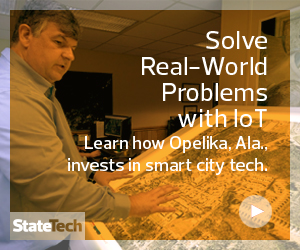Smart City Infrastructure Connects Sensors
Without adding additional hardware, Opelika can identify sensors and build applications to support them into the LoWaRan back end, Dawe says.
Of course, the entire project became possible because Opelika dedicated itself to becoming a “gig city,” running fiber through every municipal building. The municipality equipped every city building with fiber, then added more compute power and virtualized its data center.
“We bought an IBM BladeCenter H, actually,” Dawe says. “We virtualized all the servers. Then we started looking at applications for the police department. Every police car is connected by LTE through a VPN with Verizon, with encrypted data, so that they can work wherever they go,” Dawe says.
“Cities are beginning to, and will continue to, integrate technological dynamism into municipal operations, from transportation to infrastructure repair and more. The back ends of these systems are not always apparent to the end user — but as the integration of smart cities technologies becomes more visible in our everyday lives, we could begin to see large-scale changes in our cities,” states the National League of Cities in “Trends in Smart City Development.”
Kiosks and sensors may reside on the front end of a smart city project, but communication systems and broadband infrastructure serve as “the glue that holds the Internet of Things together,” NLC says.
Data Centers Key to Information Analysis
The capabilities of IoT are key to enabling smart cities.
“The key technology behind the success of smart city initiatives, whether that’s improving pollution levels or traffic conditions, is the IoT,” states Information Age. “The IoT is a network of physical connected devices, like vehicles or home appliances, that enable these ‘things’ to connect and exchange data. This in turn, is creating never-before-seen opportunities to converge the physical and the digital — via data analytics — to improve efficiency (both in public and private sectors), drive economic benefits and improve livelihoods.”
And in the end, smart cities must improve data collection and analysis to enhance the lives of citizens. Data centers, such as the one collecting input from sensors in Opelika, empower true smart cities to realize this goal.
MORE FROM STATETECH: Discover why successful smart city projects emphasize citizen rewards now!
A Dell EMC white paper, “Smart Cities and Communities,” outlines some of the challenges to making the best use of data. “Data from different departments, which is often in different formats, is not easily combined. That makes it difficult for cities to gain the analytics-driven insights that come from data comparisons. In addition, there is no easy way to integrate sensor and application data into other city systems.”
The white paper calls for the implementation of a dashboard to foster integration and provide a platform for an overview of real-time information from data analytics. Dell EMC is part of the GDT Smart City Framework, a data platform from GDT, SAP and Dell EMC based on Intel Xeon processors.












